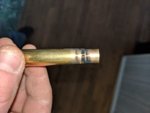Adam Gibbs
WKR
- Joined
- Aug 28, 2017
- Messages
- 520
I reloaded a very little bit about 10 years ago, but between moves and such I hadn't really done it outside of a few rounds of 308. Now that I'm a bit better established I set up my bench again with the goal of loading and actually shooting some 375 H&H on a rifle I've owned for quite some time as well.
I set up the dies the way the Lee manual described and sized 10 cases. Just for shits and giggles I dropped the cases in the chamber and closed the bolt and while the bolt closes, it is a bit harder than without a case in the chamber. When I looked at the cases after pulling them out, there appears to be a ring on the shoulder that wasn't there to begin with.
I'd assume I need to screw down the die to "shorten" the case, but how much? Or is that off base? I can't find this problem referenced in my manuals so I'm a bit confused and would rather be safe than sorry. Thanks for any help.
Lee dies
Hornady cases
Rem 700 375 H&H
I set up the dies the way the Lee manual described and sized 10 cases. Just for shits and giggles I dropped the cases in the chamber and closed the bolt and while the bolt closes, it is a bit harder than without a case in the chamber. When I looked at the cases after pulling them out, there appears to be a ring on the shoulder that wasn't there to begin with.
I'd assume I need to screw down the die to "shorten" the case, but how much? Or is that off base? I can't find this problem referenced in my manuals so I'm a bit confused and would rather be safe than sorry. Thanks for any help.
Lee dies
Hornady cases
Rem 700 375 H&H

